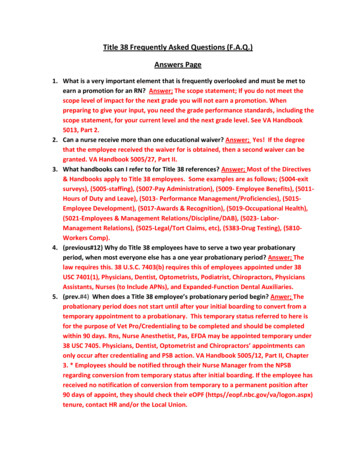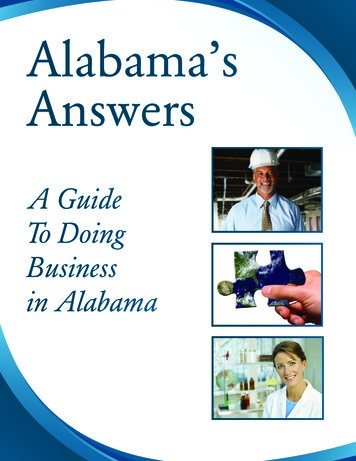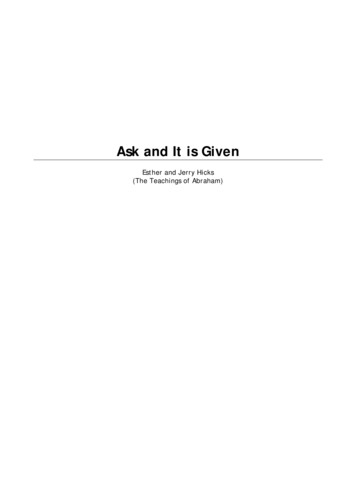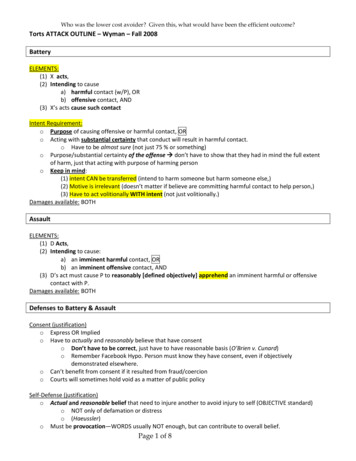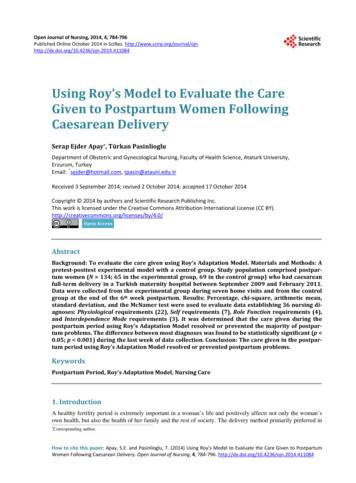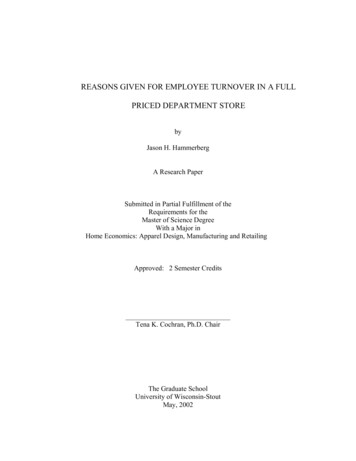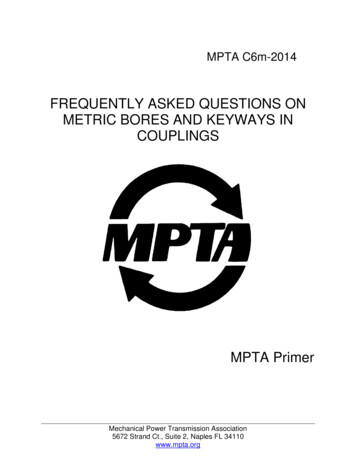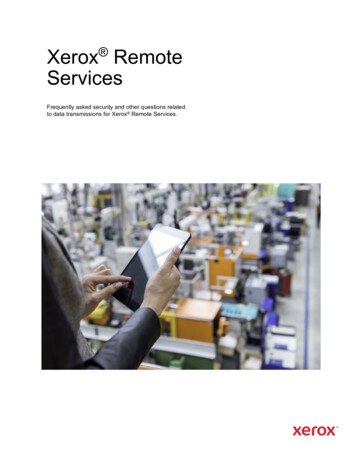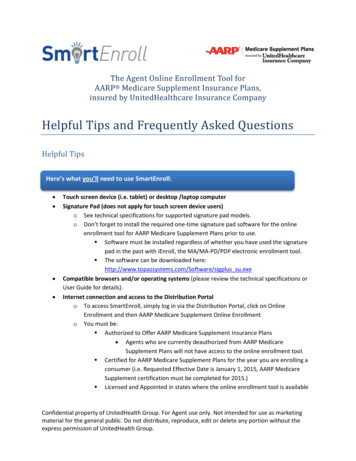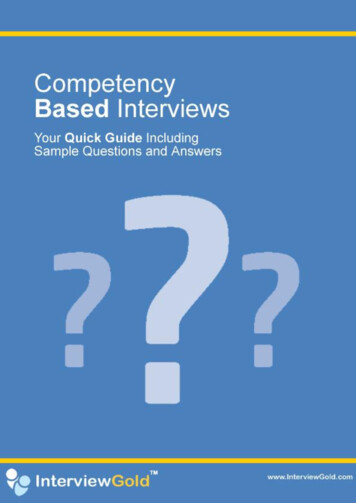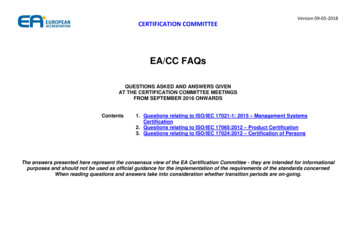
Transcription
CERTIFICATION COMMITTEEVersion 09-05-2018EA/CC FAQsQUESTIONS ASKED AND ANSWERS GIVENAT THE CERTIFICATION COMMITTEE MEETINGSFROM SEPTEMBER 2016 ONWARDSContents1. Questions relating to ISO/IEC 17021-1: 2015 – Management SystemsCertification2. Questions relating to ISO/IEC 17065:2012 – Product Certification3. Questions relating to ISO/IEC 17024:2012 – Certification of PersonsThe answers presented here represent the consensus view of the EA Certification Committee - they are intended for informationalpurposes and should not be used as official guidance for the implementation of the requirements of the standards concernedWhen reading questions and answers take into consideration whether transition periods are on-going.
CERTIFICATION COMMITTEEQuestions Asked and Answers Given1. Questions relating to ISO/IEC 17021-1 – Management Systems Certification[Back to Contents]Question 32.1 Road Traffic Safety MS ScopingThe ISO/IE TS 17021-7 does not refer to differences forscoping purposes. The differences are based on context asreferred to in table A 1 in the annex of ISO 39001.Some ABs scope in accordance with NACE codes, othrs inaccordance with Table A1What would be the appropriate scoping for ISO 39001?Question 32.2 GFSIGFSI is requiring Scheme owners to comply with theirrequirements like additional new audit items, but also to ‘audit’all elements during every audit. This appears in contradictionwith the methodology of MS certification as determined forQMS and EMS through IAF MD5 or FSMS through ISO/TS22003, which applies the audit time reduction for surveillanceand recertification audits (of 2/3 and 1/3 of the initial timerespectively). Yet AB’s are giving with their accreditation logo’sthe impression that auditing all elements is equally effective ascovering them during the whole cycle. The most clean exampleis comparison of ISO22000 versus FSSC22000.Table A 1 would appear to be the most appropriate mans of scoping for ISO 39001GFSI Guidance Document - Version 6.4 / November 2015 - Part II § 3.5.1 states :“The scheme owner shall have a clearly defined and documented audit frequency programme, whichshall ensure a minimum audit frequency of one audit per year of an organisation’s facility and has thescopeto assess all elements of the scheme’s standard.”General understanding of the clause and the sentence is that the requirements of assessing all elementslies with the audit programme and not with the annual audit (which is in the sentence the first requirementput on the audit programme). There are no contradiction between GFSI requirements and ISO/IEC17021-1 ISO/TS 22003 and related IAF MD documents.The question is:1)How do we interpret that GFSI based schemes have to‘audit’ all criteria whereas the methodology of MS certificationapplies the assessment of all criteria over the certification cyclewhich therefore allows to give a reduction for surveillance andrecertification audits.2)To enable the same amount of confidence to thesedifferent types of certification audits, should we require thatthese schemes apply a different time allocation scheme as well(i.e. above ISO/TS 22003)?Page 2/31
CERTIFICATION COMMITTEEQuestion 32.3 DurationBackground:ISO/IEC 17021-1:2015 does not specify requirements for audittime and audit duration. IAF-MD5 and e.g. ISO/TS22003describe this in more detail. MD5 describes in §4.1 that auditduration (on-site) should not be less than 80% of the audit timeindicating that planning and reporting should typically be 20%of the audit time. ISO/TS22003 is a bit clearer by mentioningthat preparation (and reporting) are not included in audit time.In practice it is noted that CAB’s consider to allocate time forreporting (else no report would be made), but time for planningand more importantly preparation of the audit team is notincluded (nor mentioned) and thus depends on the personaltime of the team members.Questions Asked and Answers GivenClause 9.1.4 of ISO/IEC 17021-1:2015 specifies the overriding requirements for audit time and requiresthat ‘for each client the certification body shall determine the time needed to plan and accomplish acomplete and effective audit of the client’s management system.’ This is confirmed by clause 0.6 of IAFMD 5 which states that ‘notwithstanding the guidance provided by this document (MD 5) the timeallocated for a specific audit should be sufficient to plan and accomplish a complete and effective audit ofthe client's management system.’It is, therefore, clear that preparation time to plan an audit is required by both ISO/IEC 17021-1:2015 andIAF MD 5.There will be evidence from witnessed audits and reports to determine whether or not the certificationbody has an effective process for planning audits. Providing the certification body has demonstrated aneffective process for planning audits and is allocating sufficient on site time to accomplish a complete andeffective audit, there is no need for it to separately justify and record planning time.Question:Could it be considered to suggest an amendment to IAF-MD5to identify whether preparation time is required, that this bejustified and recorded, and potentially indicate a ‘minimum’?Page 3/31
CERTIFICATION COMMITTEEQuestion 32.4 2-StageSome of the wording of the standard ISO/IEC 17021-1, relatedto stage I and stage II, having to be considered as one audit,conducted in two stages (9.3.1.1) cause some interpretationproblems.It is stated in a NOTE under 9.3.1.2.1 that “Stage 1 does notrequire a formal audit plan (see 9.2.3).”Secondly, 9.2.3.1 states that “The certification body shallensure that an audit plan is established prior to each auditidentified in the audit programme ”.Related questions are the following:1.What is required as the audit plan for a stage I? Is atelephone conversation acceptable?2.Since the stage II audit is not a separate audit, aformal audit plan is not required either?3.Or does this mean that the stage II audit (or the overall«initial audit») plan has to be prepared prior to stage I (i.e. priorto «the initial audit»), maybe in a more generic way, but withthe objective that the stage I provides further focus/adaptationto this plan (ref. 9.3.1.2.2.f)?4.Do the requirements for 9.2.3 (and more specifically9.2.3.2) apply to the audit plan for a stage II (even though thatis not a separate audit)? Particular attention is requested to therequirement in 9.2.3.2.a (objectives) which are quite differentfor a stageI (9.3.1.2.2) from a stage II ‘audit’ (9.3.1.3).5.Can it be required that the CAB prior to the stage I atleast will have to inform the client that prior to stage II an auditplan is prepared in line with the requirements of 9.2.3?6.A note normally does not contain requirements; howthen can a note make requirements not applicable (as is thecase here)?Questions Asked and Answers GivenThe sequence of clauses in ISO/IEC 17021-1 is as follows : § 9.1.3.2 and 9.3.3.1 : the initial audit (part of the audit programme)is a two-stage audit § 9.2.3.1: . an audit plan is established prior to each audit identified in the audit programme toprovide the basis for agreement regarding the conduct and scheduling of the audit activities. § 9.2.3.2 : “The audit plan shall be appropriate to the objectives and the scope of the audit.” § 9.2.3.2 and 9.2.3.3: give the elements to be found in each formal audit plan for each audit; Itmay come that some elements are not applicable/ necessary for stage 1.Then an audit plan is required before the initial audit (then before stage 1) so that the organisation to beaudited is aware of what is to be audited and when (“agreement regarding the conduct and scheduling ofthe audit activities”). The CB may choose to draft one unique plan for stage 1 and 2, in the form requiredper § 9.2.3.2 and 9.2.3.3, the plan addressing all elements of 9.3.1.2.2 and 9.3.1.3. If there is only oneplan, it has to be reminded to the client that the plan may be adjusted after stage 1, following theconclusions of stage 1.If the CB chooses to have a plan in 2 parts, one for stage 1, and then, after stage 1, one specific for stage2, it may accommodate the form of the stage 1 plan, as all points of § 9.2.3.2 and 9.2.3.3 may not apply.What is captured in the NOTE , is not to say that a plan is not required but is only waiving the formalaspects of the plan.From there answers to questions :1)A plan (whether separate or not) is required but does not have to be formal, focusing on theobjectives stated in § 9.3.1.2.2. If the plan is specific to stage 1 (where not the full team is present and notall elements are audited) it may waive some points of § 9.2.3.2 (c-d-e-f) as not yet identified at this stage,and of 9.2.3.3 (b-c). As does not have to be formal maybe an email or a phone call is acceptable.Records on what has been agreed with the client needed to demonstrate implementation of requirements(e.g. 9.2.3.1)2)See above : stage 2 plan is required, whether specific or integrated in the global “initial audit”plan3)An overall plan may be prepared before stage 1 (in other words the audit plan communicatedbefore stage 1 may include the elements of stage 2), with the information known by the CB at this stage ,to be reviewed after stage 1 conclusions4)All apply5)Yes, it has to be required in the case that the plan is not drafted in once6)According to ISO, Information marked as “NOTE” is intended to assist the understanding or useof the document. The NOTE intends to waive the “formal aspects” of the plan and not the full requirementPage 4/31
CERTIFICATION COMMITTEEQuestion 32.5 2-stageSome of the wording of the standard ISO/IEC 17021-1, relatedto stage I and stage II, having to be considered as one audit,conducted in two stages (9.3.1.1) cause some interpretationproblems.In 9.3.1.2.3, it is stated in a NOTE that “The stage 1 outputdoes not need to meet the full requirements of a report (see9.4.8). “We do consider that the report of the “initial audit” in its totality(i.e. the full report prepared after conclusion of stage II), doesneed to comply with the requirements of 9.4.8. This means thatit shall also include or refer to the “k) audit findings (see 9.4.5),reference to evidence and conclusions, consistent with therequirements of the type of audit” (i.e. findings, evidence andconclusions consistent with the requirements of stage I andstage II). So although the stage I findings don’t have to bereported immediately after the stage I in a report complyingwith all requirements of 9.4.8 (since then only “Documentedconclusions with regard to fulfilment of the stage 1 objectivesand the readiness for stage 2 shall be communicated to theclient, including identification of any areas of concern thatcould be classified as a nonconformity during stage 2.” have tobe reported), the stage I findings (positive and negative)should find their way into the overall “initial audit” report afterstage II.Please confirm that the above position, i.e. the report (whetherconsisting from several documents or not) in its totality shallcomply with all requirements of 9.4.8 for both stage I and stageII audits.Questions Asked and Answers GivenIn 9.3.1.2.3, it is stated that “Documented conclusions with regard to fulfilment of the stage 1 objectivesand the readiness for stage 2 shall be communicated to the client, including identification of any areas ofconcern that could be classified as a nonconformity during stage 2.”Actually “Documented conclusions” refers to “Stage I Audit Report” that does not need to meet the fullrequirements of a report as given in 9.4.8. That means not all items of audit report given in 9.4.8 arecovered.This report or “documented conclusions” shall be communicated before stage II. Since the standard is notsaying “immediately communicated”, it can be communicated immediately or later stage I. However, itshall be communicated before stage II.According to related requirements of the standard, the CB can prepare one “Initial Audit Report”consisting of two separate parts (e.g. Stage I and Stage II) or prepare two seperate audit reports; “Stage Ireport” and “Stage II report”. In the second case, most of requirements of 9.4.8 should be coveredincluding sub-item “k)” “audit findings” since there is no need to report the conclusions of Stage I as“nonconformity”, just “identification of any areas of concern that could be classified as a nonconformityduring Stage II” is enough.Since the stage I “documented conclusions” shall be communicated in any format with the client of CBand these have to be based on findings (positive and negative), these (stage I findings) should find theirway into the overall “initial audit” report after stage II provided that the conclusions are communicated withthe client after or at the end of Stage I, and before Stage II.Page 5/31
CERTIFICATION COMMITTEEQuestion 32.6 2-stageSome of the wording of the standard ISO/IEC 17021-1, relatedto stage I and stage II, having to be considered as one audit,conducted in two stages (9.3.1.1) cause some interpretationproblems.Clause 9.4.1 states that “The certification body shall have aprocess for conducting on-site audits. This process shallinclude an opening meeting at the start of the audit and aclosing meeting at the conclusion of the audit.”Does this mean that the initial audit require only an OpeningMeeting (meeting the requirements of 9.4.2) at the start of thestage I audit and a Closing Meeting (meeting the requirementsof 9.4.7) at the end of the stage II audit (i.e. no Closing Meetingat end of stage I or Opening Meeting at the start of stage II)?These would seem like a silly consequence as these auditshave clear and distinct objectives, i.e. both need full Openingand Closing Meetings.Questions Asked and Answers GivenClause 9.4.2 of ISO/IEC 17021-1:2015 states that the purpose of the opening meeting is to ‘ .provide ashort explanation of how the audit activities will be undertaken.’ Since the audit objectives and activitiesfor stage one and stage two are different, the requireme
Questions relating to ISO/IEC 17021-1: . It is, therefore, clear that preparation time to plan an audit is required by both ISO/IEC 17021-1:2015 and IAF MD 5. There will be evidence from witnessed audits and reports to determine whether or not the certification body has an effective process for planning audits. Providing the certification body has demonstrated an effective process for .
